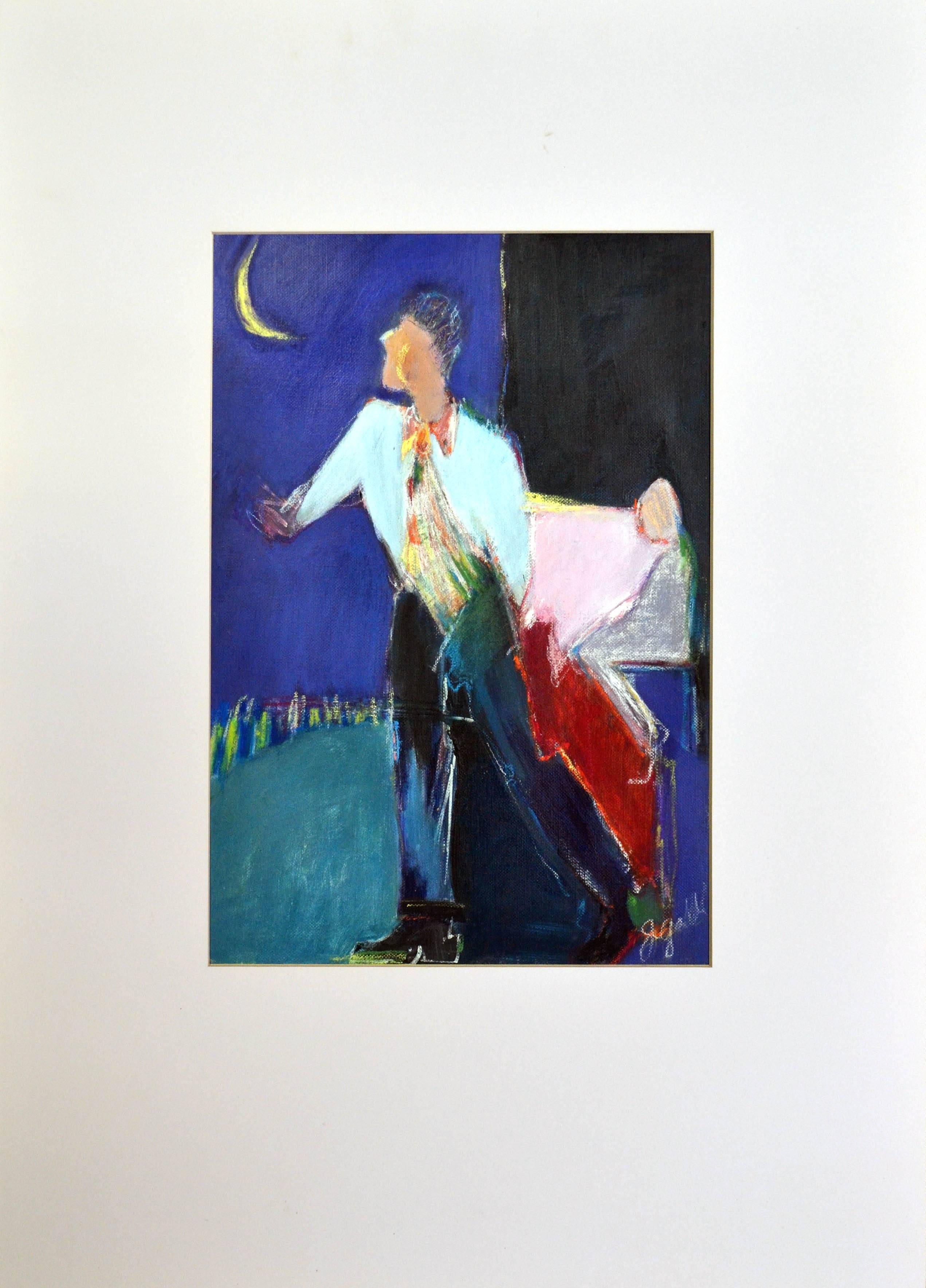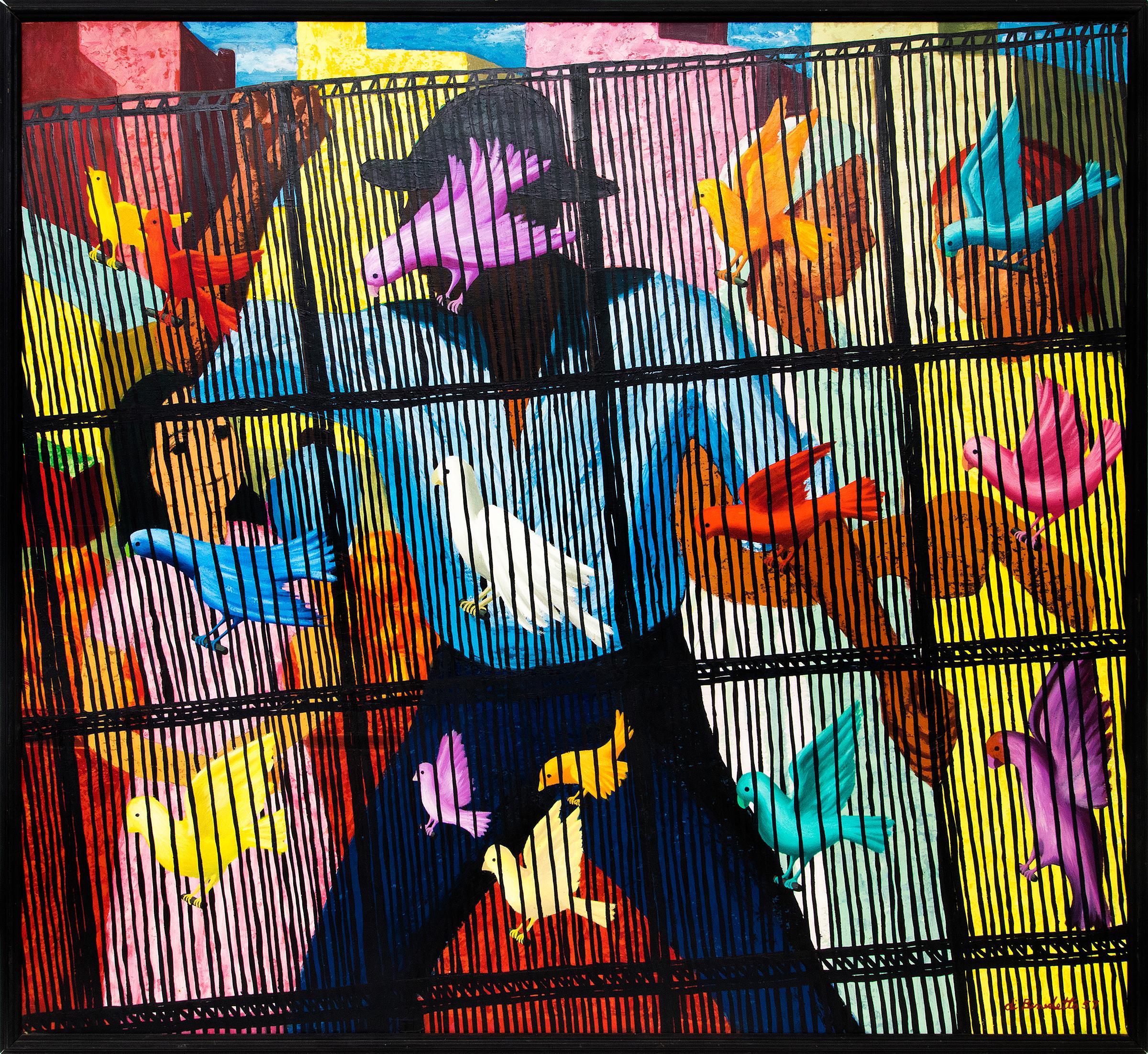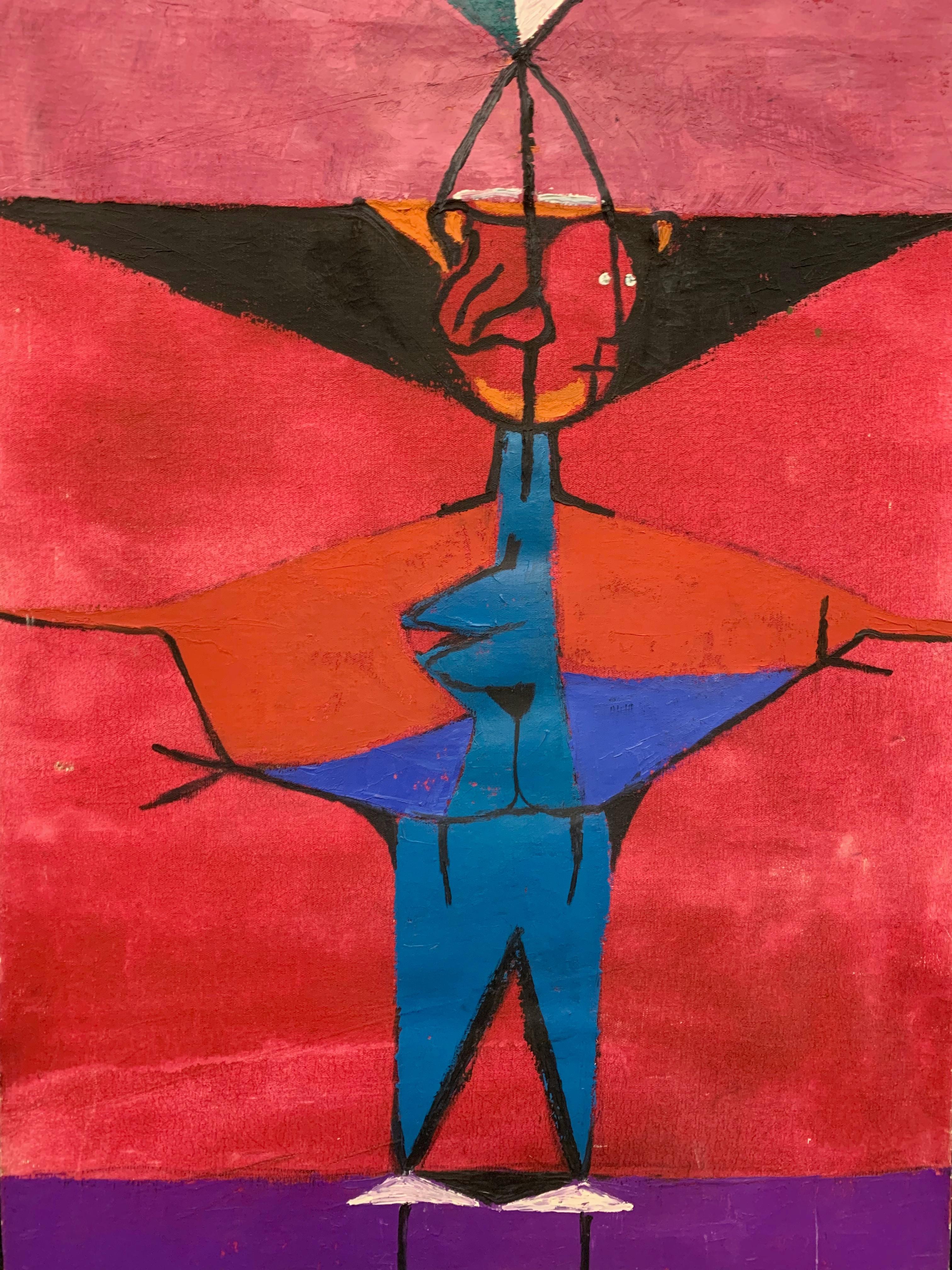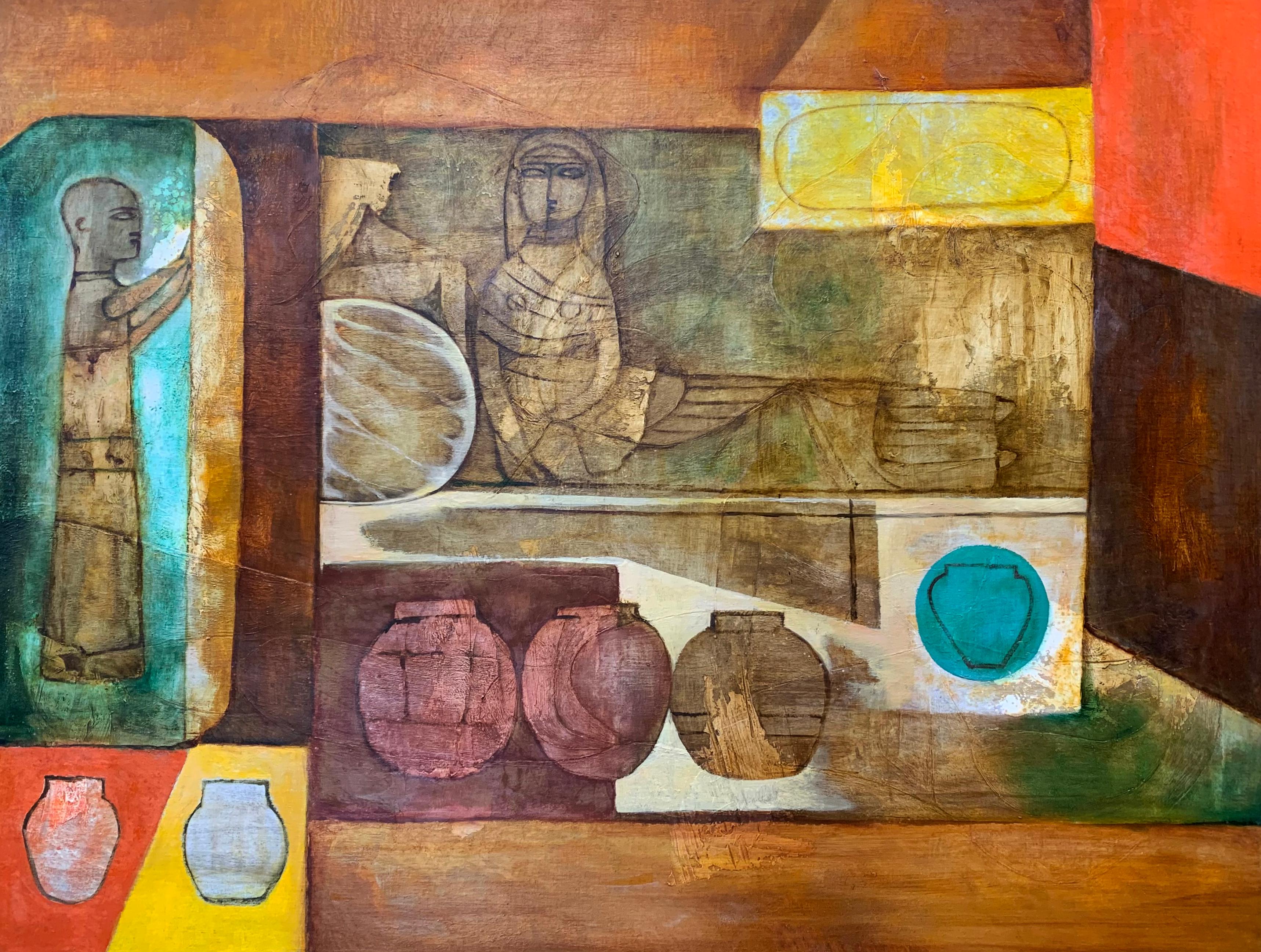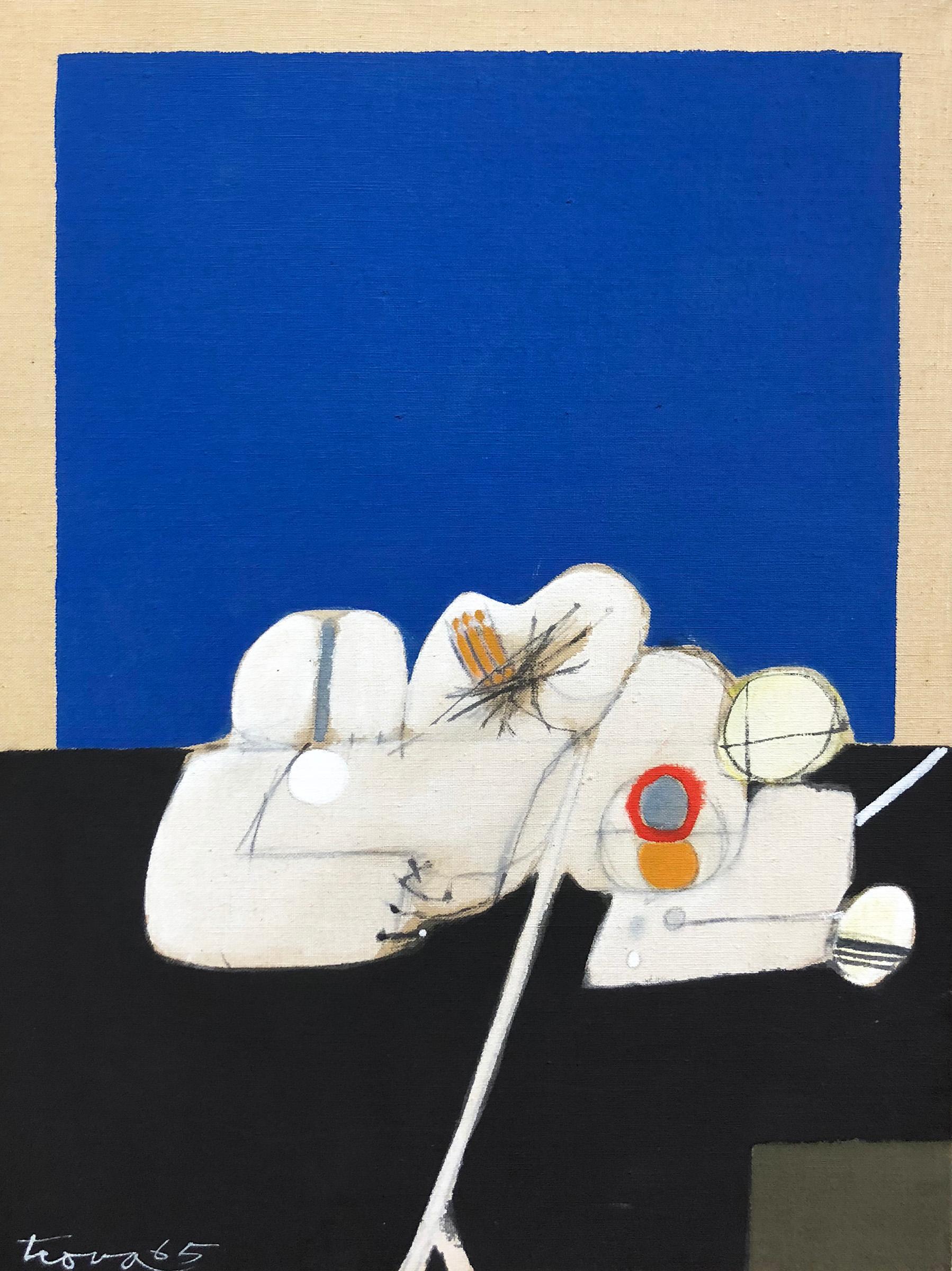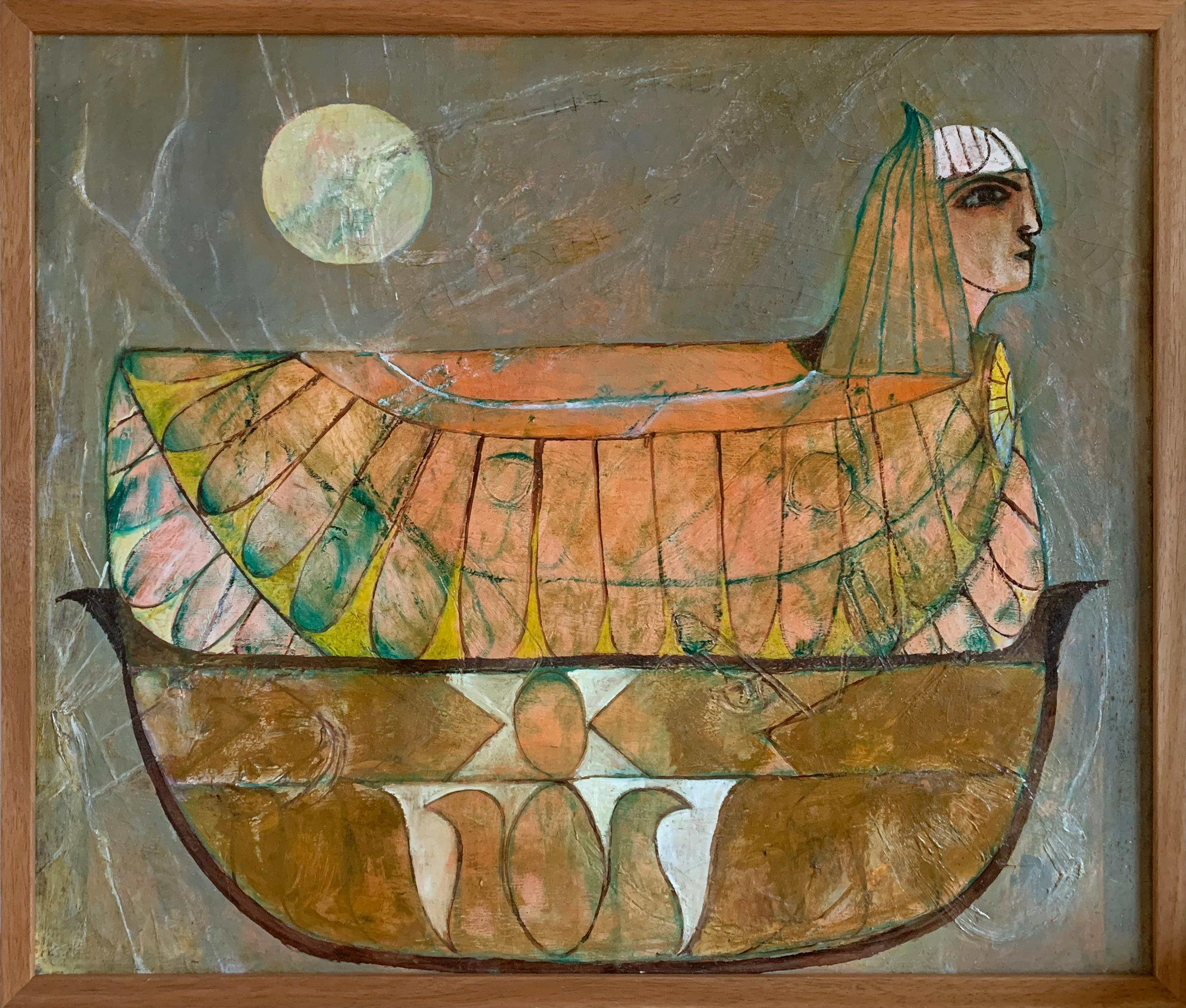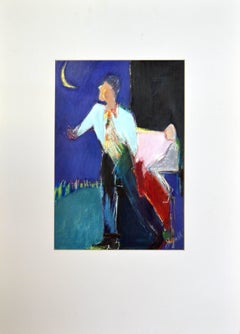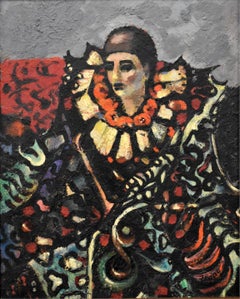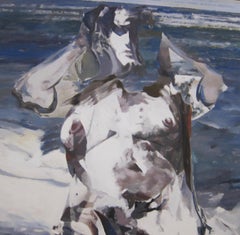
Large Figurative Abstract Oil Painting by Balcomb Greene dated 1966
View Similar Items
1 of 10
Balcomb GreeneLarge Figurative Abstract Oil Painting by Balcomb Greene dated 19661966
1966
About the Item
- Creator:Balcomb Greene (1904-1990, American)
- Creation Year:1966
- Dimensions:Height: 57.5 in (146.05 cm)Width: 51.5 in (130.81 cm)Depth: 2 in (5.08 cm)
- Medium:
- Movement & Style:
- Period:
- Condition:The artwork is in excellent condition. The vintage frame shows some wear at edges including some chips visible at edges.
- Gallery Location:Oakland, CA
- Reference Number:1stDibs: LU108624134842
Balcomb Greene
Balcomb Greene has been described as "an iconoclast, a painter who has refused to conform to the latest artistic trends." This comment was apt, for Greene was an independent-minded artist who followed his own aesthetic inclinations regardless of what was in vogue among critics and the public. At the outset of his career, he eschewed Depression-era realism in favor of a cutting-edge geometric abstract style that set him apart from the mainstream art establishment and from many of his fellow abstractionists. During the 1940s, when non-representational painting came into fashion, he began to incorporate the human form into his work, creating enigmatic figure paintings in which variations of light and shadow played a vital role in creating mood. A turning point in his career occurred in 1931, when Greene and his wife, Gertrude Glass Greene, traveled to Paris to further their understanding of vanguard art and literature. Although Greene intended to write novels in his Montparnasse studio, he soon found himself drawn to the art world and decided to become a painter. He was especially inspired by the example of Piet Mondrian, Juan Gris and the Abstraction-Creation painters, who sought to eliminate all references to nature, literature and anecdote by focusing on pure abstraction. Greene returned to the United States in 1932, going on to develop his own hard-edged abstract style, creating what he referred to as "straight line, flat paintings." In 1937, he became a founding member and first chairman of Abstract American Artists, established to promote the cause of abstraction in national art circles. In the 1930s, Greene found employment with the Works Progress Administration's Federal Art Project. He created an abstract mural for the Federal Hall of Medicine at the World's Fair of 1939. In 1940, Greene began studying art history at New York University, going on to receive a master's degree in 1943. During this period, his aesthetic approach changed as he abandoned the crisply rendered and brightly colored forms of his geometric work in favor of the figure shown against a backdrop of fragmented planes. He went on to create paintings, often naturalistic depictions of the female nude, that were characterized by an expressionist handling of paint and a limited palette of whites, greys and other muted tones that derived from his interest in photography. In 1947 Greene purchased some land on Montauk Point, Long Island. With the exception of a trip to Paris in 1958-60, he spent most of his time on Long Island, where he was one of the pioneers of the East End art colony. Inspired by the proximity of the ocean, he painted a number of marines, using dynamic brushwork to evoke the energy and spirit of the sea. Greene taught aesthetics and art history at the Carnegie Institute of Technology in Pittsburgh (1942-47), where his students included Andy Warhol and Philip Pearlstein.
You May Also Like
- Man With Moon - Figurative AbstractBy J GoldLocated in Soquel, CACompelling abstract figurative oil painting in bold, primary colors of a man and the moon by J. Gold (American, 20th Century). Signed "J. Gold" lower right. Presented in a Maple woo...Category
1980s American Modern Figurative Paintings
MaterialsOil, Paper
$700 Sale Price20% Off - "THE CLOWN" MICHAEL FRARY MID CENTURY MODERN TEXAS ARTISTBy Michael FraryLocated in San Antonio, TXMichael Frary (1918 - 2005) Austin Artist Image Size: 16 x 12.5 Medium: Oil "The Clown" Biography Michael Frary (1918 - 2005) Michael Frary was born in Santa Monica, California on Ma...Category
1960s American Modern Figurative Paintings
MaterialsOil
- Birdcage, 1950s Framed Modernist Oil Painting, Bright Colored Figures and BirdsBy Angelo Di BenedettoLocated in Denver, COBirdcage, modernist semi-abstract 1950s oil painting with a make and female figure with birds by Denver artist, Angelo Di Benedetto (1913-1992). Bright colors of yellow, red, blue, pink, black and white. Vintage 1957, oil on board, signed and dated 1957 lower right. Presented in a vintage Black frame, outer dimensions measure 49 ¾ x 53 ½ x 2 inches. Image size is 47 ½ x 51 ½ inches. The son of Italian immigrants from the Salerno province in southern Italy, as a teenager Angelo Di Benedetto worked as a truck driver in the mornings and a bartender in the afternoons to study at the Cooper Union Art School in New York City (1930-34) from which he graduated with a certificate in freehand drawing. He won a scholarship to the Boston Museum Art School where he studied for three years, beginning in 1934, with Russian émigré painter, Alexandre Jacovleff, a member of Mir Isskustva (World of Art) in St. Petersburg before the Russian Revolution. In 1936 he painted a religious mural for St. Michael's Grove in Paterson, New Jersey. The following year he entered his first juried exhibition at the Montclair Museum in New Jersey, winning first prize and first honorable mention. In December 1938 the Royal Netherlands Steamship Line sent him on a two-month ethnological study trip to Haiti, his first exposure to a different environment outside the United States. During what turned out to be an extended six-month stay, he studied and painted the life and religious customs of the island, resulting in a series of colorful, stylized paintings inspired by his immersion in the local culture. He also did scenes of Port-au-Prince and executed commissions received from prominent people in Haiti, including government officials. In 1940 his Haitian paintings were exhibited at the Montross Gallery in New York (his first solo show) and also reproduced in the January 1940 issue of Life Magazine. One of his Haitian paintings, Morning in Port-au-Prince, was owned by an American author, politician and U.S. ambassador, Clare Boothe Luce, while another image, Haiti Post Office, was acquired for the Encyclopedia Britannica Collection and later donated to Fisk University in Nashville, Tennessee. Before World War II Di Benedetto traveled extensively around the United States in his car and trailer doing regional paintings. In 1941 he did what is considered the first authentic version of George Washington Crossing the Delaware, a contrast to the well-known painting on the same subject (1851) by German-born painter, Emanuel Gottlieb Leutze. During the war Di Benedetto volunteered for a secret mission to Africa in 1941 before the Allied invasion, serving as director of camouflage, foreman of native laborers and an interpreter while based in Eritrea. The following year he received a direct commission as a Second Lieutenant in the U.S. Army Air Corps in the First Photo Mapping Squadron, leading groups as a guide and interpreter and doing ground control. During his free time in Africa, he sketched and painted the local population and his fellow servicemen. Following Africa, he served as an orientation officer and aerial photographic officer for the 311th Photo Wing at Bolling Field, in the District of Columbia where he did a series of illustrated articles describing the natives in the different countries where the men of his organization were stationed during the war. In 1945 he was assigned to a mapping unit at Buckley Air Field in Denver where he served until his discharge in 1946. Like many other servicemen stationed at the time in Colorado, Di Benedetto chose to remain in Colorado impressed by the state's physical grandeur and healthful climate. After the war, he lived briefly for about a year in Rangely, a small town in northwest Colorado where he traveled and sketched. But finding it a little too remote, he settled in the old mining town of Central City in 1947, his home base for the rest of his life. He spent his first six years there transforming the old Sauder-McShane Mercantile warehouse into a giant art studio. His initial acquaintance with the town's mining town history in 1947 resulted in a drawing, Death of a Miner, showing a male figure buried under a pile of collapsed rock in a mining tunnel. In 1949 Di Benedetto and his wife, ceramist Lee Porzio, opened the Benpro Art School in his studio where he conducted summer art classes. The following year he teamed up with a Denver-based artist, Frank Vavra, to open the Denver Art Center at 924 Broadway. He and Vavra were founding members of the 15 Colorado Artists who seceded in 1948 from the Denver Artists Guild because they were dissatisfied with the older organization's underlying conservatism and the disdain of some of its members for modern art. Welcoming anyone wanting to learn how to draw or paint, the Denver Art Center in downtown Denver only lasted about a year. Undeterred by its lack of success, Di Benedetto continued throughout his career to give workshops, classes, and lectures on art-related topics in Denver and elsewhere. Examples of topics ranged from subjects such as "African Art," Chappell House, Denver (1945) and "University or Artistic Thought" sponsored by the Art for World Friendship Committee (1954). He also taught locally at the Jewish Community Center, Steele Community Center, International House, Southern Colorado State College-Pueblo, and lectured at the University of Denver. Beginning in 1969 he sponsored over one hundred youths at his studio in Central City to spend a summer learning about art. He also conducted classes for serious working artists. His efforts earned him an honorary doctorate from the University of Colorado in 1977. He likewise promoted contemporary Colorado artists' work in the 1950s, heading a committee that presented one-person exhibitions in a small gallery at the Vogue Art Cinema on South Pearl Street in Denver. His interest in promoting the arts led to his participation in numerous organizations. In the 1960s he became concerned with environmental and urban art and was the president of Art for the Cities, a Denver-based nonprofit organization. He also was the chairman of and a participant in the first annual environmental art exhibit held at Denver's American Medical Center. In 1968 Colorado Governor John Love appointed him to the Colorado Council on the Arts and Humanities in which he remained active until 1975. He served for two consecutive years as program coordinator for the Governor's Conference on the Arts and Humanities. At the 1969 conference, Governor Love presented him an award for his contribution to the art and artists of Colorado. At the same time, he actively participated in the civic life of Central City. The town's Police Magistrate (1955-56), he twice campaigned for mayor, first in 1966 and again in 1973, and ran for commissioner in 1979. He socialized with artists Ben Shahn, Herbert Bayer and Mark Rothko, as well as theatrical stars appearing at the Central City Opera House, including Helen Hayes, Mae West, and Gypsy Rose Lee. He invited them to carve their autographs on his kitchen table. Di Benedetto worked with equal facility in a variety of media: acrylic, oil paint, watercolor, charcoal, Conte crayon, graphic arts and metal (copper, iron). Up until the early 1950s, his output was dominated by representational figure work and expressionist Colorado landscapes that were not always immune from controversy. When Life Magazine included a reproduction of his Regionalist painting, Lovers in the Cornfield (1941) in its article, "Ten Years of American Art: Life Reviews the Record of a Lively, Important Decade" (November 26, 1946, issue), three counties in Massachusetts banned the publication. Just as immediately, the painting was exhibited in Denver. He said that he liked the West because of the people, despite their lack of exposure to art, were individualistic and almost "anarchistic." In the early 1950s he did woodcuts in a modernist style, including Remembrance, showing his two young daughters. Influenced by Abstract Expressionism at that time, he began considering the elimination of the image from his work. By the end of the decade, he had decided that "the circle – pure and simple was one of the most familiar symbols of mankind and that it metaphored into everything." At the same time, he noted that "99% of the abstract painters shied away from using...[the circle]. When they didn't, they slaughtered it, murdered it and buried it. So it became my motif." For more than three decades he explored the circle in paint, sculpture and shaped canvas. Two examples of the last-named medium are his Red CQ and Black C-1, both from 1969. Because abstraction touched upon his deep feelings and spirituality, he felt he could make visible that part of life which "we feel but almost never see." His fascination with the circle also relates to his belief that to effect the dialogue existing between object and maker; the artist must "create archetypal shapes [that have universal appeal], not symbols... to reflect simply the intrinsic beauty of the shape itself." A strong advocate for public art, Di Benedetto headed Art for the Cities, Inc., which sponsored nine sculptures for Burns Park as part of the Denver Sculpture Symposium held in the Mile High City in 1968. The catalysts for the idea of the sculptures were Beverly and Bernie Rosen, who had been instrumental in the creation of the contemporary department at the Denver Art Museum. Along with Di Benedetto, the other participating sculptors were Dean Fleming...Category
1950s American Modern Figurative Paintings
MaterialsOil, Board
- Awanyu, American Modernist and Southwestern Painting by Female Artist, 1930'sLocated in Doylestown, PA"Awanyu" is a 18 x 24 inches, oil on canvas painting by American modernist, female artist Peter Miller. The work is painted in a vibrant color palette, a signature of Peter Millers' style, often inviting her sense of lively spirituality into her paintings. The title "Awanyu" is derived from the Native American Tewa beliefs and traditions. Avanyu (also Awanyu), is a Tewa deity, the guardian of water. Represented as a horned or plumed serpent with curves suggestive of flowing water or the zig-zag of lightning, Awanyu appears on the walls of caves located high above canyon rivers in New Mexico and Arizona. The work is estate stamped 202063 on verso and framed in a natural wood floater frame. The painting has been conserved and inspected by conservation specialist, Gratz Gallery & Conservation Studio, Inc. American artist Peter Miller (1913-1996) was born Henrietta Myers in Hanover, Pennsylvania. She began using the name Peter Miller after concluding her studies at the Pennsylvania Academy of the Fine Arts in 1934 and her marriage to fellow artist and Academy student Earle Miller in 1935. She felt collectors and critics would take her paintings more seriously if she was identified as a male. In childhood, Henrietta and her best friend Ruth picked fictitious nicknames for themselves, and Henrietta reportedly decided upon the name Peter because she liked the idea that it was derived from the Greek word for “rock” or “stone”. Drawn to being one with the natural world would prove to be an essential inspiration to her creativity throughout her life. Miller is classified as an American Modernist, a reputation she earned for having shown at the prestigious gallery and premiere showcase for Surrealist painting of Julien Levy in New York in the 1940s. Reviewers of her exhibitions noted the unmistakable influence of the artists Joan Miró, whose work she owned and whom she knew, and Arthur Carles, whom she studied with, and sources in Native American culture, which came from sharing time between her home state of Pennsylvania and New Mexico. Peter and her husband Earle considered New Mexico their spiritual home, and in 1935 they built a ranch in Española, about 25 miles north of Santa Fe. Being neighbors of the indigenous people of the Tewa Pueblo, their crafts and religious beliefs fascinated Peter and the reliance of Native Americans upon the land and the animals permeated her work for most of her career. Their belief that all creatures could serve as intermediaries in communication with the spiritual world, inspired Miller to incorporate their symbols in her own paintings, along with signs drawn from indigenous pottery...Category
1930s American Modern Abstract Paintings
MaterialsCanvas, Oil
- "Shattered" WPA Mid 20th Century Modernism American Scene Surrealism FigurativeBy Leon BibelLocated in New York, NY"Shattered" WPA Mid 20th Century Modernism American Scene Surrealism Figurative Estate stamp on the stretcher, verso. Provenance: Estate of the artist. 20 x 24 inches. BIO Leon Bibel continued painting through 1941 and resumed work in both painting and especially wood sculpture by 1960. He worked until his very last day in 1995. His last series of large wood sculptures were modeled on spice boxes, which were miniature buildings...Category
1930s American Modern Figurative Paintings
MaterialsCanvas, Oil
- "Pink Triangle" "Pink Triangle" 1950s Bay Area Figurative Movement Female ArtistLocated in Arp, TXFrann Spencer Reynolds (1926-2008) "Pink Triangle" c 1950s Oil on canvas 24"x32" float mount white distressed wood frame 26"x34.25" Signed on reverse Go...Category
Mid-20th Century American Modern Abstract Paintings
MaterialsCanvas, Oil
